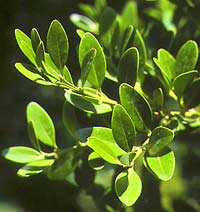 |
|
(Photo: dtlbm) |
Buxus, commonly known as Boxwood, is an evergreen plant that is highly regarded in landscape design and is often cultivated in estates. Its leaves are leathery and have a thick cutin layer in the epidermal cells, allowing it to withstand toxic gases such as SO2, Cl, H2S, and HF. This plant excels at absorbing these harmful gases, thereby purifying the air. It ranks second among nine plants known for their chlorine absorption.
 |
| (Photo: biologie) |
Buxus has many variations and can be classified as either a shrub or a small tree, typically growing to about 6 meters in height. It belongs to the Buxaceae family. The branches are four-angled, and the leaves are leathery, oval-shaped, with a slightly concave or blunt tip. The upper surface of the leaves is a deep green, while the underside is significantly lighter. In spring, it produces small yellow flowers that bloom in clusters at the leaf axils.
Buxus grows very slowly; it can take over 10 years for its diameter to reach just 10 cm. A centuries-old specimen located in front of the Guanzhong Temple in Suzhou, China, is 700 years old yet stands no taller than 10 meters with a circumference of only 30 cm.
Buxus tolerates pruning well and is often used for hedging or shaping in gardens. Its wood is fine and dense, commonly used for crafting decorative items and making combs.


















































